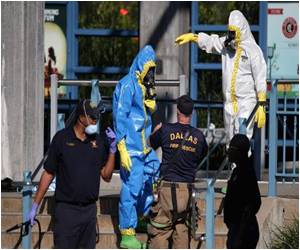A special report on radiology preparedness for handling cases of Ebola virus has been issued by Radiologists from the National Institutes of Health and Emory University School of Medicine.

"Clear and frequent communication with the healthcare staff is essential during this time of heightened public concern and understandable caution," said report co-author Carolyn C. Meltzer, M.D., from the Departments of Radiology and Imaging Sciences, Psychiatry and Behavioral Sciences, and Neurology at Emory University School of Medicine in Atlanta. "For example, at Emory University Hospital, open Town Hall information sessions, the wide dissemination of standardized screening protocols, and close intra- and interdepartmental communication have supported a safe environment in caring for patients with Ebola virus."
In the U.S., there are currently four biocontainment facilities with specialized isolation rooms and staff trained to treat patients with Ebola virus: Emory University Hospital in Atlanta, NIH Clinical Center in Bethesda, Md., St. Patrick Hospital in Missoula, Mont., and Nebraska Medical Center in Omaha. Additional tertiary care institutions have been preparing staff and facilities to handle patients with Ebola virus.
"Medical imaging does not provide diagnosis of Ebola virus disease, but patient assessment in the emergency department and treatment isolation care unit is likely to require imaging services," said the report's co-author, David A. Bluemke, M.D, Ph.D., director of the Department of Radiology and Imaging Sciences at the NIH Clinical Center.
At present, the role of medical imaging in Ebola care is to exclude other diagnoses or assess complications of the virus. For the radiology team to provide the best possible medical care for the patient while maintaining full protection of the medical staff, medical imaging exams of patients with Ebola virus should be performed within a specialized isolation unit.
Portable X-ray units and bedside ultrasound imaging have been used in biocontainment units. At the NIH, training sessions for the radiology staff directly involved in Ebola patient care involves in-depth information on the background and spread of the virus, as well as isolation unit procedures.
Advertisement
Currently, two different strategies exist. In the first, the radiologic technologists do not enter the patient's room, known as the Hot room. In this approach, medical technologists instead stay in the Warm room (anteroom) and provide verbal instructions for equipment use to nurses or physicians in the Hot room. In the second approach, radiologic technologists enter the Hot room to assist in operation of the imaging equipment. This approach is needed when the equipment may be somewhat more complex.
Advertisement
Preparation for procedures in the Hot room includes ensuring that all supplies are in place (including lead aprons, equipment disinfectant/wipes and equipment covers) and batteries in the portable equipment are fully charged. The X-ray detector is then double bagged and each bag is separately zip-locked prior to entering the patient's room.
During the procedure, close cooperation between the isolation unit nurse and the radiologic technologist is necessary.
Transporting a patient with Ebola virus to the radiology department for a medical imaging procedure is not advisable and requires additional precautions. For example, the patient transportation route must be coordinated with the hospital's infection control team.
In addition, disinfection of radiology procedure rooms requires many hours and may prohibit diagnostic treatment of other patients in the facility. CT and MRI equipment are not designed for imaging of patients with Ebola or other highly contagious diseases. Small crevices in the gantry table and moving parts are extremely difficult to protect with plastic covers, and bodily fluids can accumulate in narrow recesses that are inaccessible to surface cleaning.
"Radiology staff directly involved in the care of patients with Ebola virus disease need to be identified and educated regarding procedures of the isolation unit and regarding appropriate donning and doffing of correctly-sized personal protective equipment," Dr. Bluemke said. "Open and frequent communications are essential."
Source-Eurekalert











